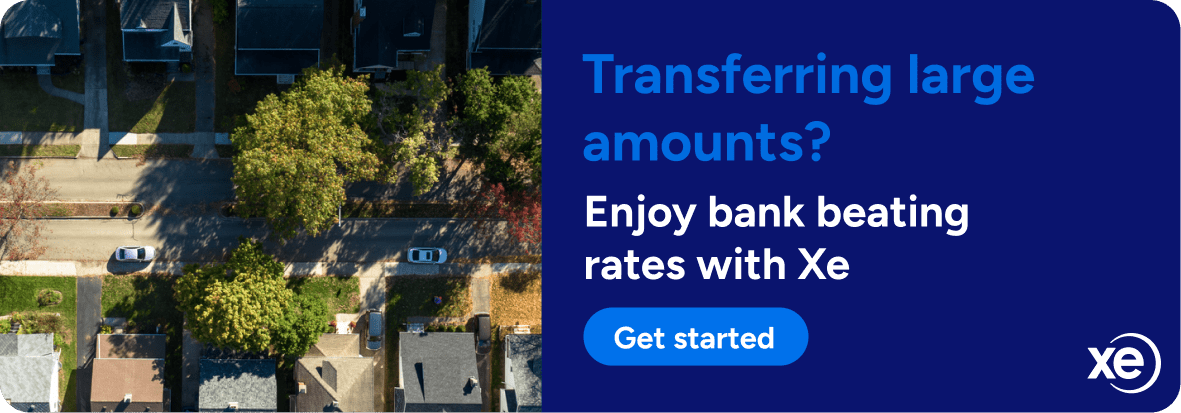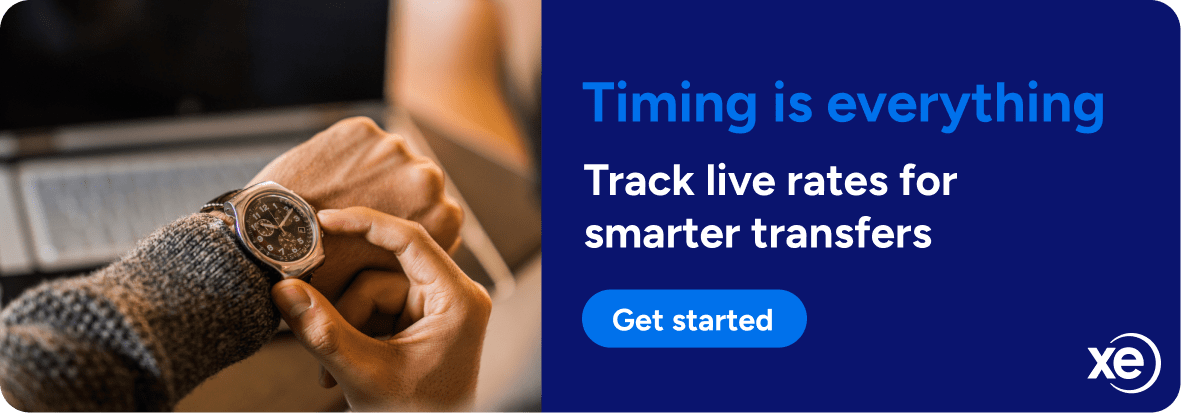- Home
- Blog
- Money Transfer
- What Is IBAN and When Is It Used?

What Is IBAN and When Is It Used?
20 March 2025 — 6 min read
Table of Contents
- What is an IBAN?
- How Does an IBAN Work?
- Benefits of IBAN transfers
- IBAN examples: What does an IBAN number look like?
- IBAN vs. SWIFT Code: What’s the Difference?
- When do you need an IBAN?
- When do you need a SWIFT code?
- Which countries use IBAN?
- Why was IBAN created?
- Where can I find my IBAN number?
- How to check if an IBAN is valid
- Making IBAN transfers with Xe
Key takeaways
IBAN (International Bank Account Number) ensures your money reaches the right account when sending internationally
Learn the important differences between IBAN and SWIFT codes and exactly when to use each
Discover how to find your IBAN and which countries require it for smooth international transfers
Need to send money abroad without delays or errors? In many countries, especially across Europe, an IBAN is essential for your transfer to reach its destination. This standardized format helps route your payment accurately, saving you time and potential frustration.
This straightforward guide breaks down everything you need to know about IBANs - from what they are and how they work to finding yours and understanding when they're required. With the right information, you can make international transfers with confidence.
What is an IBAN?
An IBAN (International Bank Account Number) works like a detailed postal address for your bank account, helping your money find its exact destination during international transfers. This standardized format pinpoints the specific account that should receive funds, making the process more accurate and efficient.
How Does an IBAN Work?
An IBAN contains up to 34 characters arranged in this specific format:
CC XX BBBB AAAA AAAA AAAA AAAA
CC – Country code (2 letters, like GB for the UK)
XX – Check digits (2 numbers that validate the entire code)
BBBB – Bank identifier (unique to each financial institution)
AAAA... – The specific account number
Each IBAN follows a structured format to ensure payments are processed correctly. While they may look complicated at first glance, each character serves a specific purpose in helping route your payment accurately.
The length of IBAN numbers varies by country, but the format will always begin with the country code and check digits. The check digits are particularly important, as they're calculated using a complex algorithm that helps verify the IBAN's authenticity.
Benefits of IBAN transfers
The IBAN system offers several key advantages for anyone sending money internationally:
Functions as a verification system, confirming details before processing
Creates a universal format that works across different banking systems
Expedites processing between IBAN-using countries
Protects against typing errors that could misdirect your funds
Reduces the need for manual intervention, lowering costs and speeding up transfers
Improves traceability, making it easier to track payments if issues arise
For everyday users, this means fewer rejected payments, faster processing times, and greater peace of mind when sending money abroad.
IBAN examples: What does an IBAN number look like?
IBAN formats vary by country. Below are some examples¹:
Country | IBAN example | Length |
|---|---|---|
United Kingdom | GB33BUKB20201555555555 | 22 |
Germany | DE75512108001245126199 | 22 |
France | FR7630006000011234567890189 | 27 |
Spain | ES7921000813610123456789 | 24 |
Italy | IT60X0542811101000000123456 | 27 |
Each IBAN follows a structured format to ensure payments are processed correctly.
IBAN vs. SWIFT Code: What’s the Difference?
Both IBAN and SWIFT codes play an important role in international banking, but they serve different purposes.
Feature | IBAN | SWIFT code |
|---|---|---|
Purpose | Identifies an individual bank account | Identifies a bank and branch |
Use case | Needed for payments within IBAN regions | Used worldwide for all bank transactions |
Format | Up to 34 characters | 8 to 11 characters |
Regulated by | ISO 13616 Standard | SWIFT Organization |
Think of it this way: a SWIFT code directs your money to the right bank, while an IBAN guides it to the specific account within that bank. For complete routing information, many international transfers require both codes.
When do you need an IBAN?
You’ll need an IBAN if you’re:
Sending money within Europe or IBAN-adopting countries in the Middle East or Asia
Making transfers within the Single Euro Payments Area
Verifying your account with some online payment platforms and services.
When do you need a SWIFT code?
You’ll need a SWIFT code if you’re:
Making international transfers outside IBAN zones
Making a transaction that requires both IBAN and SWIFT for accurate processing
Dealing with correspondent banking relationships (i.e transfers between banks that don't have direct relationships)
Performing transfers to major economies like the US, Canada, Australia, and much of Asia
Even within IBAN regions, SWIFT codes are often still used alongside IBANs to provide complete routing information.
Which countries use IBAN?
The IBAN system has spread worldwide since its introduction, though adoption varies significantly by region. Here's a quick overview of where you'll need an IBAN for your international transfers:
Countries that require IBAN:
Europe (all EU countries, UK, Norway, Switzerland, etc.)
Middle East (UAE, Saudi Arabia, Qatar, etc.)
Parts of Africa & Asia (Pakistan, Tunisia, Mauritius, etc.)
Caribbean (Dominican Republic, Saint Lucia, etc.)
Countries that do not use IBAN:
United States – Uses routing numbers and account numbers
Canada – Uses bank codes and transit numbers
Australia – Uses Bank State Branch (BSB) codes and account numbers
China – Uses domestic clearing codes
Japan – Uses domestic bank codes
Why was IBAN created?
Before IBAN, sending money internationally was often a headache. Banks used different account formats across countries, leading to frequent errors, lost payments, and lengthy delays.
Transfers were prone to mistakes, resulting in rejected payments and unexpected fees
IBAN introduced a standardized format that works seamlessly between different banking systems
The system quickly became essential throughout Europe and has since spread to the Middle East and beyond
By creating a universal "language" for account numbers, IBAN made cross-border payments faster and more reliable
What began as a European solution has now expanded globally, with countries across multiple continents adopting the system for its clear benefits to international banking.
Where can I find my IBAN number?
Finding your IBAN is easy. Here's where to look:
Bank Statement: Many banks print the IBAN on account statements
Online Banking: Log into your account to check your banking details
Mobile Banking Apps: Many banks include IBAN information in their apps
Contact Your Bank: If you're unsure, your bank can provide the correct IBAN
Bank Cards: Some banks print part of the IBAN information on debit cards
Many financial institutions offer an IBAN checker or IBAN validation tool on their websites to verify your IBAN before making a transaction. These IBAN lookup tools can help confirm you’ve formatted your IBAN correctly to avoid transfer delays.
How to check if an IBAN is valid
If you want to validate an IBAN before sending money, you can:
Use an online IBAN calculator
Check that the country code matches the destination country
Verify that the length matches the standard for that country
Ensure all characters are valid (letters and numbers only)
Most banking platforms will automatically validate the IBAN format before processing your payment.
What if my bank doesn’t provide an IBAN?
If your country doesn’t use IBAN, you’ll need a SWIFT code and additional details to process an international payment.
Making IBAN transfers with Xe
IBAN has transformed international banking, offering a simple way to process transactions efficiently and securely. Knowing how IBAN works ensures your payments reach their destination without issues.
Why use Xe for IBAN transfers?
Competitive Exchange Rates: Save more on international transfers.
Low Fees: Avoid hidden charges from traditional banks.
Fast & Secure Payments: Many transactions settle within minutes.
Simple Online Platform: Easily send IBAN transfers from your phone or computer.
Send money internationally with Xe today at Xe.com and experience hassle-free IBAN payments.
Citations
¹ IBAN Countries- IBAN - 2025
**The information from these sources were taken on March 20, 2025.
The content within this blog post is not intended for use as financial advice. This content is for informational purposes only. Different currency exchange amounts, currency types, dates, times, and other individual factors will result affect the delivery times of transactions, rates and comparative savings.
Smarter money transfers
Xe combines bank-beating rates, secure transfers, and global reach to make moving money across borders fast, easy, and affordable.

10 June 2025 — 6 min read

4 June 2025 — 6 min read

22 May 2025 — 5 min read

21 May 2025 — 5 min read

20 May 2025 — 7 min read

15 May 2025 — 7 min read



